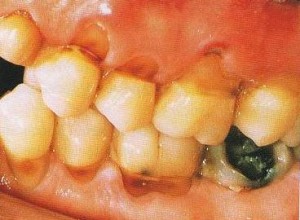
© Australian Denture Care Centre
Toothbrush abrasion is a type of dental abrasion which is commonly seen in the mouth. It is most frequently on the junction where the teeth meet the gums (gum line or gum margins) and the root surfaces of teeth.
Toothbrush abrasion is the result of traumatic tooth brushing in a horizontal scrubbing movement rather than a vertical direction and appears as notches worn into the teeth near the gum margins which can be made worse by abrasive dentifrices. Changes can be detected anywhere in the mouth, although the upper teeth are usually more involved than the lower teeth.
What causes toothbrush abrasion?
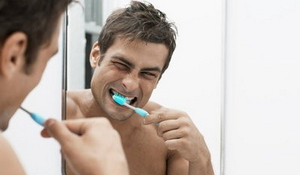
© Dental Health Magazine
Hard bristles, worn bristles, pressure applied during brushing, improper brushing techniques and abrasiveness of dentifrices used can all influence the degree of toothbrush abrasion.
Besides external factors, toothbrush abrasion can occur in receding gum margins which exposes the root surface of the tooth. Our gums recede as we get older and when the gums are inflamed, as seen in gum diseases. However toothbrush abrasion itself can also cause gum recession.
Harmful effects of improper tooth brushing
Initially, toothbrush abrasion can cause trauma to the gums, which can appear as red, brushing or depressed lesions. Long-term toothbrush abrasion can lead to gum recession or clefts on the gums. The receding gum margins will expose the root surface of the tooth which is thinner than the tooth enamel of the crown and can result in notches and sensitive teeth.
Will toothbrush abrasion heal?
Unfortunately toothbrush abrasion does not heal by itself as the tooth wear is permanent.
What to do once you have toothbrush abrasion
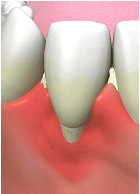
© Dental Focus
- Visit your attending dentist to discover the cause of the toothbrush abrasion and monitor the condition of your teeth.
- A minor notch, if detected early, may not need major treatment and can be managed with desensitizing agents.
- A deeper notch will require greater attention. If the notch is left exposed, food and bacteria can become trapped in hidden corners and this will lead to tooth decay. Furthermore the deeper notch can weaken the tooth and can result in tooth fracture if you bite too hard. Your dentist will repair the toothbrush abrasion with tooth-colored materials (composite / glass ionomer cements) that help fill up the notch, improve appearance and reduce teeth sensitivity.
- The receded gum margins can only be corrected with surgical procedures that reposition the gums back into place (flap surgery). Â If you are comfortable with the gum line, it can be left as it is.
How to prevent toothbrush abrasion
1. Choosing the right toothbrush
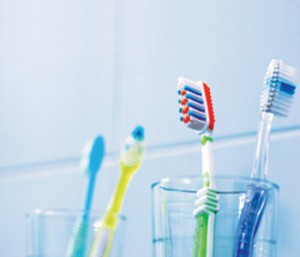
© SPH Magazines Pte Ltd. Co.
The size and style of the toothbrush are your personal decisions as there are many types available in the market. It is generally recommended to use soft-bristled brushes with small head size.
Soft bristles are less likely to cause damage to the gums or any exposed root surfaces of the teeth and they also adapt to the shape of the tooth better. The small head size enables the toothbrush to reach the areas in the back of the mouth for cleaning the teeth in the area without hurting the mouth.
A power toothbrush can be used to decrease brushing force and overzealous tooth brushing.
2. Replace worn toothbrush
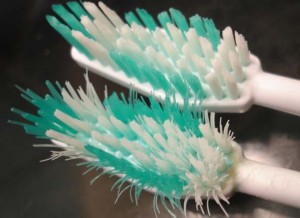
© Save My Smile
Toothbrushes should be replaced as soon as the bristles show signs of wear, splay, fray or when the color indicator changes color. Generally, this is every 8 to 12 weeks. A worn toothbrush would not be able to clean as efficiently as a normal one.
3. Use a less abrasive toothpaste
4. Modify your tooth brushing method
There are several types of tooth brushing techniques. The Bass method (named after Dr. C. Bass) is the most commonly recommended technique. This proper tooth brushing method is effective in removing plaque and food debris directly beneath the gum margins. It is important to clean the gum margins to avoid gum diseases. There is also a modified Bass technique whereby you add a rolling stroke following brushing the inner part of the gum margins.
The Bass method
A. Place the toothbrush with the bristles directed straight into the gum sulcus about 45-degree angle to the tooth.
B. Press lightly so that the tips of the bristles go into the gum sulcus. Vibrate the brush back and forth with very short strokes. Approximately 10 gentle strokes should be completed without removing the bristle ends from the gum sulcus before proceeding to the next area. The brush head is moved to the next tooth or group of teeth by overlapping with the completed area.
C. Hold brush in a vertical position and use gentle back-and-forth strokes to clean the inner surfaces of the teeth.
D. Place bristles on the top of the teeth surface and move the brush in scrubbing or small circular motions.
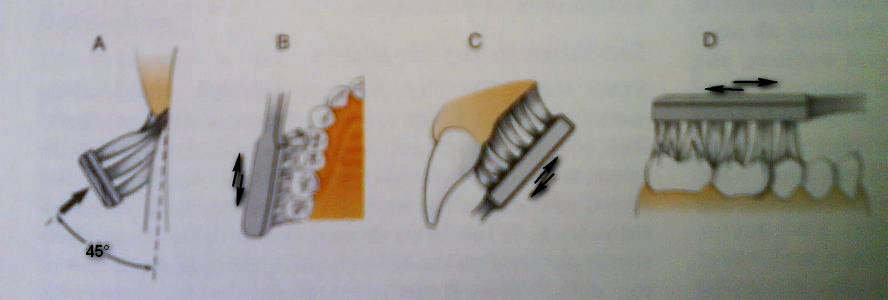
© Saunders
Pingback: How Your Daily Habits Can Hurt Your Teeth | Intelligent Dental
This is the main reason I love http://www.intelligentdental.com. Stunning post.
Pingback: Why is Oral Health so Important? | Intelligent Dental
Great information! I’ve been looking for something like this for a while now. Thanks!
Pingback: Oral Health: Relationship between the body and mouth I | Intelligent Dental